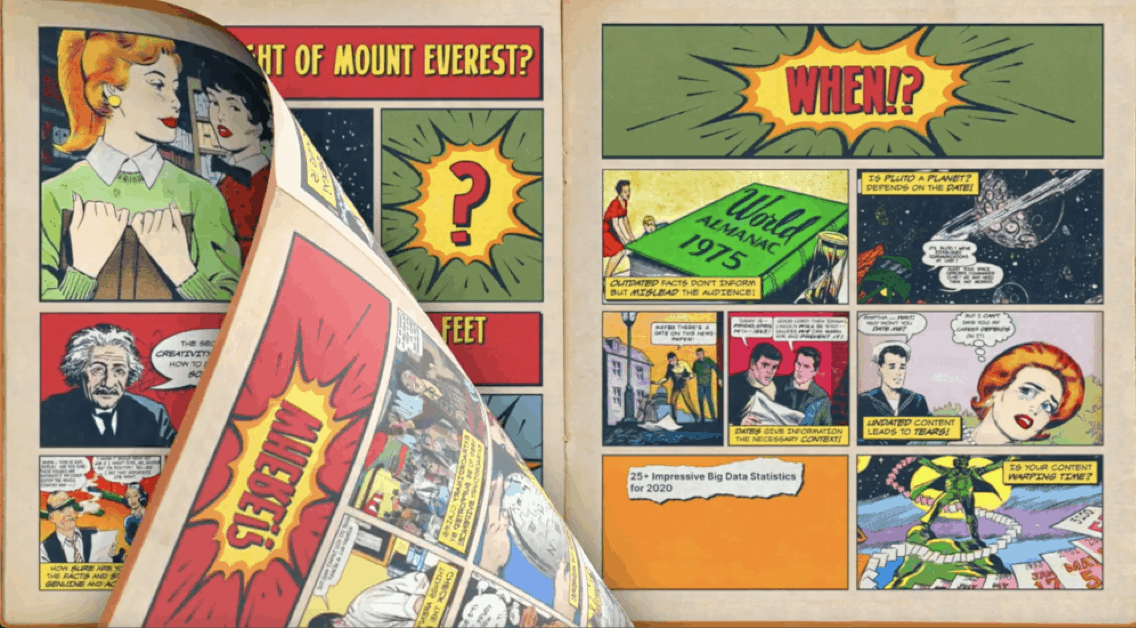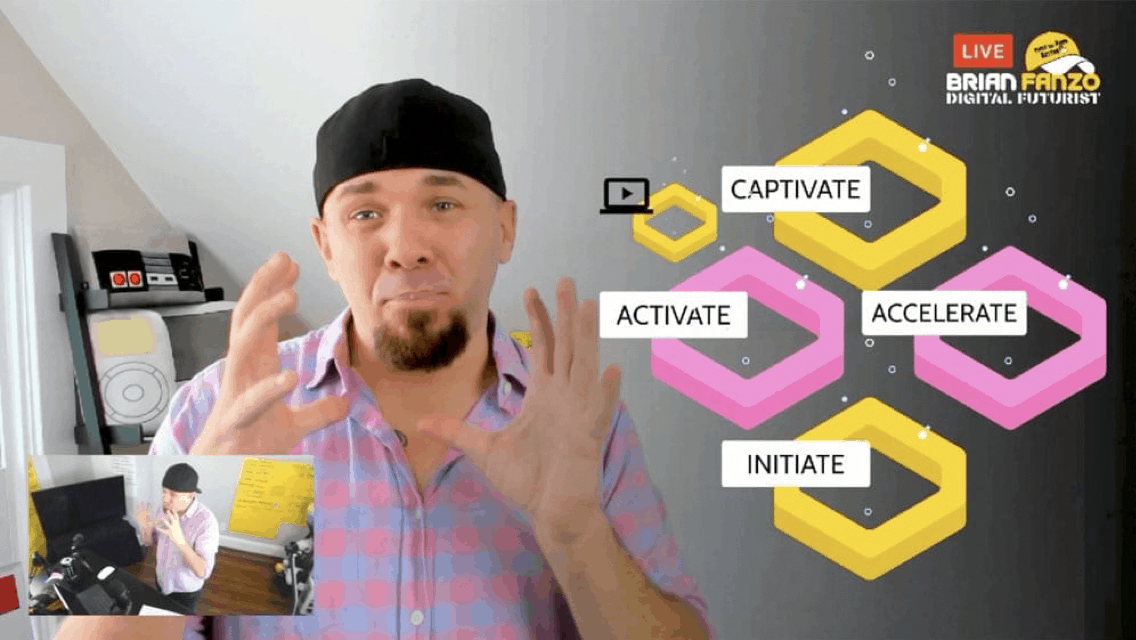Online conferencing technology has been around since the 1990s, but the word “webinar” didn’t appear until 1998.
Most people’s first experience of a webinar would likely have been a disembodied voice accompanying a slide deck presentation – perhaps with a couple of interactive features such as a poll or simultaneous chat function for people to ask questions.
For a long time, it seemed like webinars didn’t change that much. My most recent experience presenting a webinar was pretty much the same as my first back in 2008. So, you’d be forgiven for thinking webinars were yesterday’s format – a bit stale and unsurprising when compared with some of the more recent virtual trends.
Except, for reasons that should be obvious, webinars saw a huge uptick in attendance in 2020. According to On24’s Webinar Benchmarks Report, people watched three times more webinar content in April 2020 than the 2019 monthly average.
Of course, all forms of online content got a boost in 2020. The explosion in virtual events saw virtual presenters giving virtual keynotes full of virtual effects and virtual interactions, sending the expectations of their virtual audiences into the virtual stratosphere.
So, what’s the diff?
A “webinar” is a portmanteau word combining web and seminar – and a seminar is defined by Merriam-Webster as “a meeting for giving and discussing information”. So, a webinar could describe any scheduled virtual gathering where one or more people presents information to an audience of attendees.
In that case, all of those virtual events, keynotes and classrooms are webinars of one kind or another. It’s just that people usually associate “webinar” with a particular style of content – a style of content seemingly stuck in 1998.
Webinars aren’t separate from all of these other virtual presentations; all of these other virtual presentations are natural evolutions of the webinar. Therefore, webinars can – and should – incorporate most, if not all, of their innovations. In fact, many of the major webinar platforms already support the same features – or at least support the necessary integrations – so why not use them?
Be more visually creative
You may be thinking that a webinar is already a visual experience. Slides are supposedly visual – except when they’re a series of flat backgrounds covered with text. (Please stop that!) However, there’s so much more you can do.
Don’t hide behind your slides. Just like a live event, a big part of a presentation is the presenter. The audience wants to see you.
By looking into the camera (eye contact), the presenter connects directly with each member of the audience.
The content is enhanced by the presenter’s expressions and body language.
Instead of relying on slides to convey the information, the presenter can include other visual elements, such as props, or even perform a demonstration on camera.
2020 saw an explosion of visual creativity as presenters and teachers of all kinds found increasingly creative ways to reinvent their presentations and lectures to better capture and hold an audience’s attention through the screen.
For example, one of my favourite speakers – whether on stage or online – is Andrew Davies. When lockdown forced him to begin presenting virtually, he transformed a room in his home into a dedicated studio, rethinking how to best present his ideas visually – without resorting to slides. In fact, I don’t think I’ve seen Drew use a single slide in any of his virtual keynotes, whether live or pre-recorded.
My favourite of his innovations is the lightboard, which Drew came up with as a way to recreate the experience of explaining ideas on a whiteboard without the awkward back-to-camera thing.
Know the platform
To think more visually about your webinar, you need to know how the audience will experience it.
Many platforms support a split-screen effect, allowing the slides and the presenter to appear alongside each other.
I used this knowledge when planning my presentation for Content Marketing World last year, using a green screen and adding a frame to the video of me so that the two windows created a comic-book effect that complimented my image choices.
However, when I presented the same talk for the State of Social ’20, I was told that my pre-recorded presentation would appear in a single window, requiring me to adapt my approach. To keep the slide visuals moving, I created a series of comic page layouts in Prezi and animated the transitions to between each panel/slide to replicate the experience of reading a comic. Once I had captured all of the slides and transitions in a video, I edited them into my presentation and added some other comic-themed overlays to complete the effect.
Yes, getting more creative with pre-recording and editing a video presentation takes more time than building a slide deck and presenting the talk live. I certainly spent longer than intended on testing ideas and experimenting with various tools and techniques. But I should be able to reuse the same templates, processes and overlays to speed up production considerably next time.
Speaking of overlays, Prezi has another option available for presenters eager to ditch the slides. Prezi Video launched in 2019, allowing presenters to appear alongside or even interact with their visual content within the same window.
Instead of sharing the screen with one slide after another, presenters can overlay animated graphics to bring the content to life without losing that eye-contact connection with the viewer. And it works with live streaming too (yay, no editing!).
Prezi Video integrates easily with just about any video conferencing and webinar platform you might want to use.
If you want ideas on how to use Prezi Video to create interactive virtual presentations, check out Prezi evangelist Brian Fanzo.
Pre-record or live?
But if you’re pre-recording your webinar, why try to recreate a live experience anyway? Why not just publish it as evergreen on-demand content?
The On24 benchmarks report found that pre-recorded webinars published straight to on-demand didn’t perform as well as live or even simu-live (pre-recorded video presented as live) webinars. A webinar that is always available eliminates any time pressure, making it easier for people to keep putting it off. The urgency and fear of missing out is gone.
In short, your pre-recorded webinars will be more successful if you still schedule and promote them as if they were live events, motivating more people to register.
However, it’s still possible to create a live webinar experience with a pre-recorded video (simu-live). For example, you can still participate and moderate the session to create the same live experience by interacting with attendees and responding to questions in the Chat.
Or, depending on your chosen platform, you may be able to switch between live streamed and pre-recorded video to combine the best of both. Similarly, livestreaming software such as Switcher Studio can give you control over multiple cameras and video sources to combine them into a single seamless stream – which can also save you editing time.
So, when planning your next webinar, think beyond the slide deck. With a little more planning and creative thinking, you may be able to draw upon a much wider pallet of visual tools and styles to keep your audience engaged, informed and entertained.


